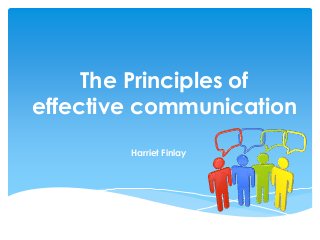
Effective communication
- 1. The Principles of effective communication Harriet Finlay
- 2. Interpersonal skills Interpersonal skills include … Verbal Communication Non verbal communication Listening skills Negotiation Problem solving Decision making Assertiveness Positivity
- 3. Barriers to effective communication The use of jargon Emotional barriers Lack of attention/Distractions Physical disabilities Physical carriers Language/ accent differences Cultural differences
- 4. Written communication Emoticons LKJACB Note taking Reports
Editor's Notes
- We use interpersonal skills to communicate and interact with other people both individually and as part of a group. Employers often look for staff with good interpersonal skills because they want employees who can work well in a team and will be able to communicate well with colleagues and clients.Interpersonal skills include verbal communication, non verbal communication (e.g. body language), listening skills, negotiation, decision making, positivity & assertiveness. Verbal communication (also known as talking) is a way of passing on information through sound (speech). verbal communication includes both conscious and unconscious gestures such as facial expressions, hand gestures and body language. Body language can reveal things about you for example if you are nervous (you may be looking down and avoiding eye contact).Good listening skills – listening is different to just hearing because listening means that you are actually taking in what information is being said and possibly asking questions to clarify.Negotiationis a method used in order to settle differences, this is important in the work place in order to be able to work with no major conflicts.Problem solving – problems in the working environment occur daily so you must be able to solve problems because in some cases failure to do so can cause businesses to be unsuccessful.Decision making - you need to be able to explore and analysis options to make the right decision for the situation because if the right decision is made it enable businesses to proceed smoothly without hitches.Assertiveness– being assertive means that you are able to express your beliefs effectively and respectfully.
- The use of jargon:Over-complicated, unfamiliar and/or technical terms. People who are not fully aware of the correct definition of the jargon used may not get the correct message because they won’t fully understand.Emotional barriers:Some people may find it difficult to express their emotions and some topics may be completely 'off-limits' eg – touchy subjects – some people may not know what to say or how to respond.Lack of attention, interest, distractions: or irrelevance to the receiver. Distractions such as background noise, other people around doing other things, hunger, thirst, tiredness can all lead to lack of concentration and attention.Differences in perception and viewpoint: People don’t always have the exact same idea which is a potential barrier. When a conflict of different ideas occur, negotiation is needed to come to a mutual decision.Physical disabilities:such as hearing problems or speech difficulties.People who can’t hear or speak may communicate in different ways, for example sign language which uses manual communication and body language to convey messages. If you can’t understand or do sign language it may be difficult to communicate with somebody with that disability so it is a potential barrier.Physical barriers to non-verbal communication:Not being able to see the non-verbal cues, gestures, posture and general body language can make communication less effective. This can be a barrier on emails and phone calls because you can’t see facial expressions and body language of who you are talking to.Language/ Accent differences: People who don’t speak the same language and don’t share a mutual language will struggle to convey messages through words so have to try and use actions and body language to communicate which is a barrier because messages may be misinterpreted. Accents can also be a barrier because the pronunciation of words is different so they may not be recognised and also different vocabulary is used (slang) which may not be understood.Cultural differences: The norms of social communication vary greatly in different cultures, so do the way that emotions are expressed. Body language varies around the world eg in japan, people may take a slight bow when hey meet you whereas in the UK we usually shake hands.
- Emoticons: A emoticon is a representation of a facial expression such as:-) , in electronic communications to express the writer's feelings or intentional tone. Effective use of emoticons can enhance written communication because although you can’t see peoples face, you can get an idea of the emotions that they are feeling and what there face would look like if you were actually talking face to face with them. Sometimes it can be hard to tell how a message was intended to sound if it’s sent over text, email or fax because you can’t hear the tone in which it was intended, so emoticons can also help determine the manner of the message.Note taking:Note-taking is the recording of information (usually written in short hand) taken from another source. By taking notes, the writer records the main points of the information that they are looking at / hearing about. Notes are usually made in meetings, lectures and lessons. Notes enable you to recall accurately rather than try and remember with the possibility of forgetting important details or getting them slightly wrong/ mixed up. You should take notes because you won’t be able to remember everything said but if you’re taking notes you can just take what you think are the most important bits of information. Reports: a report is a written account of something that one has observed, heard, done, or investigated; it’s made with the specific intention of relaying information or recounting certain events in a widely presentable form.